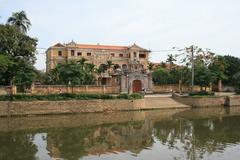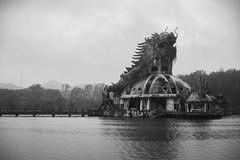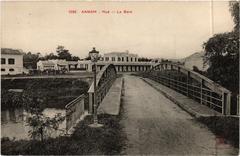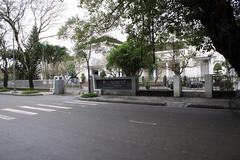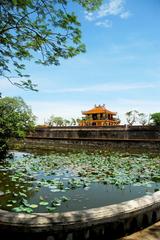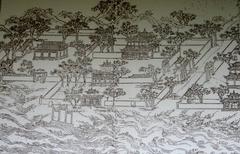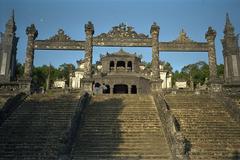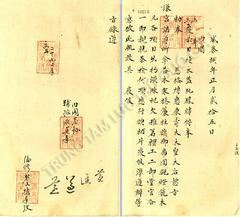
Tomb of Đồng Khánh: Visiting Hours, Tickets, and Historical Significance in Huế, Vietnam
Date: 04/07/2025
Introduction
The Tomb of Đồng Khánh stands quietly amid the lush landscapes of Huế, Vietnam, offering travelers a distinctive window into the country’s imperial past. As the final resting place of Emperor Đồng Khánh (1864–1889), the ninth ruler of the Nguyễn Dynasty, this mausoleum uniquely reflects a pivotal historical era marked by both enduring Vietnamese traditions and emerging Western influences. The tomb’s architecture and symbolism tell a story of adaptation, cultural fusion, and resilience during a time of profound change. This comprehensive guide provides visitors with essential information on the tomb’s history, architectural highlights, practical details—including visiting hours and ticket prices—accessibility, and travel tips for an enriching experience (Vietnam Vacation, iTour Vietnam, Vietnam Online).
Table of Contents
- Introduction
- Historical Context of Emperor Đồng Khánh
- Construction and Architectural Evolution
- Architectural Features and Artistic Highlights
- Visitor Information
- Nearby Attractions
- FAQs
- Summary and Recommendations
- References
Historical Context of Emperor Đồng Khánh
Emperor Đồng Khánh ruled Vietnam during a turbulent period shaped by the increasing presence of French colonial powers. After the exile of Emperor Hàm Nghi, Đồng Khánh ascended the throne in 1885, favored by the French for his compliance and openness to Western customs. His brief reign (1885–1889) was characterized by political complexity and cultural blending, themes that are vividly reflected in the design and decoration of his tomb (Wikipedia).
Construction and Architectural Evolution
The Tomb of Đồng Khánh, also known as Tư Lăng, is notable for its protracted construction, which spanned over three decades and was completed under the oversight of four emperors: Đồng Khánh, Thành Thái, Duy Tân, and Khải Định (Vietnam Vacation). This extended timeline, alongside the shifting political and economic climate, led to a fascinating blend of architectural styles.
The original site was a temple built by Đồng Khánh in honor of his father, which was later adapted into his mausoleum. As a result, the tomb’s layout and style differ markedly from the more monumental tombs elsewhere in Huế, reflecting both necessity and innovation (iTour Vietnam, Vietnam Online).
Architectural Features and Artistic Highlights
Fusion of East and West
The Tomb of Đồng Khánh is celebrated for its harmonious blend of Vietnamese imperial motifs and Western decorative elements. Key features include:
- Vietnamese Traditions: Curved tiled roofs with upturned eaves, intricate wooden carvings, and symbolic representations of dragons, phoenixes, and lotus flowers.
- Western Influences: Stained glass windows, arched doors, and European-style plasterwork, reflecting the emperor’s affinity for Western aesthetics (iTour Vietnam).
The Ngung Hy Temple at the heart of the complex features 24 drawings from the Confucian classic “Nhị thập tứ hiếu” (Twenty-four Filial Exemplars), blending Confucian ethics with Western painting techniques.
Decorative Arts and Symbolism
Inside the tomb, visitors encounter:
- Gold Leaf and Lacquer: Columns and ceilings adorned with luxurious lacquer and gold leaf, highlighting imperial opulence.
- Mosaics and Murals: Ceramic and porcelain mosaics depict auspicious symbols—dragons (power), phoenixes (prosperity), and bats (happiness).
- Stained Glass: European-imported colored glass creates colorful patterns of light across temple interiors.
- Stone Statues: Life-sized mandarins, horses, and elephants stand in silent tribute in the courtyards.
- Stele Pavilion: Houses a stone stele inscribed with the emperor’s biography, surrounded by calligraphic panels displaying Confucian poetry and maxims.
Visitor Information
Visiting Hours
- Open Daily: 7:00 AM – 5:30 PM (Vietnam Vacation)
- Tip: Early morning or late afternoon visits are best for cooler temperatures and fewer crowds.
Tickets and Passes
- Ticket Price: 100,000 VND for adults; free for children under 12.
- Combo Passes: Available for visitors planning to see multiple Huế historical sites, such as the Imperial City and other royal tombs. Combo tickets offer cost savings and are valid for two days.
- Where to Buy: Tickets are sold at the entrance and through official tourism sites or local agencies (HoiAnPrivateTaxi).
Accessibility
- Terrain: The tomb features gently sloping paths and compact courtyards, making it accessible for most visitors. However, uneven stone paths and steps may present challenges for those with limited mobility.
- Facilities: Restrooms and shaded seating are available near the entrance. Small souvenir shops and food stalls are located just outside the gate.
Travel Tips
- Dress Code: Wear modest clothing covering shoulders and knees as a sign of respect.
- Footwear: Comfortable shoes are advised for uneven paths.
- Hydration: Bring water, especially during warmer months.
- Photography: Permitted throughout the site, but avoid flash inside temple buildings.
- Guided Tours: Local guides are available for hire at the entrance and provide valuable context on the tomb’s history and symbolism.
Nearby Attractions
- Tomb of Tự Đức: A neighboring royal tomb, renowned for its tranquil lakes and pavilions.
- Vong Canh Hill: Offers panoramic views of the Perfume River and countryside (Trip101).
- Imperial City (Citadel): UNESCO-listed complex of palaces and temples in central Huế (FrontierTravelVietnam).
- Thien Mu Pagoda: Iconic seven-story Buddhist temple on the riverside.
- Dong Ba Market: Central Huế’s bustling traditional market.
- Other Royal Tombs: Including those of Minh Mạng, Khải Định, and Thiệu Trị (WhereAngieWanders).
FAQs
Q: What are the Tomb of Đồng Khánh visiting hours?
A: The tomb is open daily from 7:00 AM to 5:30 PM.
Q: How much are tickets?
A: 100,000 VND for adults; free for children under 12; combo tickets available for multiple sites.
Q: Is the site wheelchair accessible?
A: Most areas are accessible, but some uneven stone paths may require assistance.
Q: Are guided tours available?
A: Yes, English-speaking guides can be hired at the entrance or booked through agencies.
Q: Can the Tomb of Đồng Khánh be visited with other Huế sites?
A: Absolutely. Its proximity to other royal tombs and the Imperial City makes it ideal for combined itineraries.
Q: Are there combined tickets?
A: Yes, combo tickets for multiple tombs and the Imperial City are available and valid for two days.
Summary and Recommendations
The Tomb of Đồng Khánh is a hidden gem among Huế’s royal mausoleums, offering a compelling narrative of Vietnam’s late imperial era through its unique fusion of Vietnamese and Western architectural elements. Its tranquil setting and less crowded atmosphere provide a contemplative alternative to Huế’s more famous tombs. With convenient opening hours, affordable ticketing, and accessibility features, it is ideal for history enthusiasts, architecture lovers, families, and travelers alike.
For the best experience, visit during the dry season (March–August), arrive early or late in the day, and consider hiring a guide for richer historical context. Combine your visit with nearby attractions to fully appreciate Huế’s imperial heritage.
References
- Đồng Khánh, 2025, Wikipedia
- Tomb of Đồng Khánh, 2025, Vietnam Vacation
- Tomb of Đồng Khánh, 2025, Vietnam Online
- Tomb of Đồng Khánh, 2025, iTour Vietnam
- Visiting the Tomb of Đồng Khánh, 2025, Where Angie Wanders
- Tomb of Đồng Khánh Entrance Fee, 2025, Vietnam Vacation
- Trip101: Things to do in Huế
- FrontierTravelVietnam: Huế City Guide
- HoiAnPrivateTaxi: Huế Entrance Fee
For interactive maps, audio guides, and exclusive content on Vietnam’s heritage sites, download the Audiala app.







